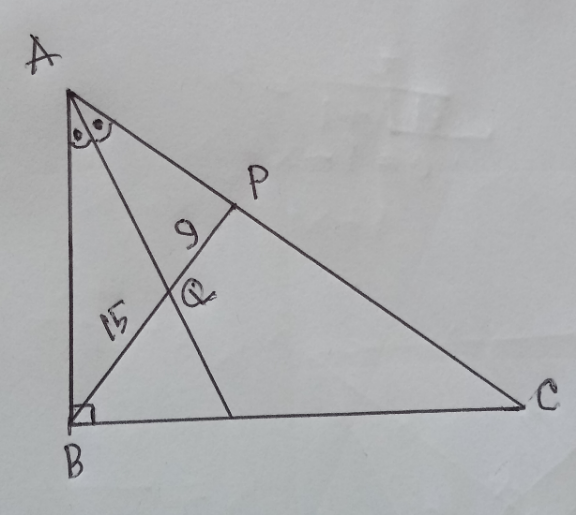Question Number 206157 by cortano21 last updated on 08/Apr/24

Commented by cortano21 last updated on 08/Apr/24

$$\:\:\:\:\:\cancel{\underline{\underbrace{ }}} \\ $$
Commented by A5T last updated on 09/Apr/24

$${This}\:{is}\:{generally}\:{not}\:{uniquely}\:{defined}.\:{One}\:{can} \\ $$$${come}\:{up}\:{with}\:{mathematically}\:{correct}\:{solutions} \\ $$$${with}\:{different}\:{answers}.\:{Points}\:{A}\:{such}\:{that}\: \\ $$$$\frac{{AB}}{{AP}}=\frac{\mathrm{5}}{\mathrm{3}}\:{lie}\:{on}\:{the}\:{Apollonius}\:{circle}. \\ $$
Commented by A5T last updated on 09/Apr/24

Answered by dimentri last updated on 08/Apr/24

$$\:\:\frac{\mathrm{AP}}{\mathrm{AB}}\:=\:\frac{\mathrm{9}}{\mathrm{15}}\:=\:\frac{\mathrm{3}}{\mathrm{5}} \\ $$$$\:\:\bigtriangleup\mathrm{APB}\:\bot\:\mathrm{in}\:\mathrm{P} \\ $$$$\:\:\mathrm{AP}=\:\mathrm{18}\:,\:\mathrm{AB}=\mathrm{30} \\ $$$$\:\:\mathrm{BP}^{\mathrm{2}} \:=\:\mathrm{AP}.\mathrm{PC}\: \\ $$$$\:\:\mathrm{PC}\:=\:\frac{\mathrm{576}}{\mathrm{18}}\:=\:\mathrm{32} \\ $$$$\:\:\mathrm{area}\:\mathrm{of}\:\bigtriangleup\mathrm{ABC}\:=\:\frac{\mathrm{50}×\mathrm{24}}{\mathrm{2}}=\:\mathrm{600} \\ $$
Commented by mr W last updated on 08/Apr/24

$${i}\:{think}\:{it}\:{is}\:{not}\:{said}\:{that}\:{AP}\bot{BC}. \\ $$
Answered by mr W last updated on 08/Apr/24

Commented by mr W last updated on 09/Apr/24

$${say}\:{AB}={x} \\ $$$$\frac{{AP}}{\mathrm{9}}=\frac{{x}}{\mathrm{15}}\:\Rightarrow{AP}=\frac{\mathrm{3}{x}}{\mathrm{5}} \\ $$$$\left(\mathrm{15}+\mathrm{9}\right)^{\mathrm{2}} ={x}^{\mathrm{2}} +\left(\frac{\mathrm{3}{x}}{\mathrm{5}}\right)^{\mathrm{2}} −\mathrm{2}{x}×\frac{\mathrm{3}{x}}{\mathrm{5}}\:\mathrm{cos}\:\alpha \\ $$$$\Rightarrow{x}^{\mathrm{2}} =\frac{\mathrm{7200}}{\mathrm{17}−\mathrm{15}\:\mathrm{cos}\:\alpha} \\ $$$${area}\:{of}\:\Delta{ABC}: \\ $$$$\Delta=\frac{{x}^{\mathrm{2}} \:\mathrm{tan}\:\alpha}{\mathrm{2}}=\frac{\mathrm{3600}\:\mathrm{tan}\:\alpha}{\mathrm{17}−\mathrm{15}\:\mathrm{cos}\:\alpha} \\ $$$${we}\:{see}\:{the}\:{triangle}\:{ABC}\:{is}\:{not} \\ $$$${unique}\:{and}\:{its}\:{area}\:{is}\:{also}\:{not} \\ $$$${unique}. \\ $$$${for}\:{locus}\:{of}\:{point}\:{A}\:{see}\:{also} \\ $$$${Q}\mathrm{181759} \\ $$
Commented by mr W last updated on 08/Apr/24

Answered by A5T last updated on 08/Apr/24
![WLOG, let Q(0,0) be the origin and BP coincide with the real axis. Then, B(−15,0), P(9,0). A(a,b) ⇒C(−b−15,a+15) AB=(√((a+15)^2 +b^2 ));BC=(√(b^2 +(a+15)^2 )) ⇒AB=BC =5y⇒PC=y(5(√2)−3) ⇒24^2 =25y^2 +y^2 (5(√2)−3)−5y^2 (5(√2)−3)(√2) ⇒y^2 =((576)/(34−15(√2)))⇒[ABC]=((25y^2 )/2)=((122400+54000(√2))/(353)) ≈563.081✓](https://www.tinkutara.com/question/Q206193.png)
$${WLOG},\:{let}\:{Q}\left(\mathrm{0},\mathrm{0}\right)\:{be}\:{the}\:{origin}\:{and}\:{BP} \\ $$$${coincide}\:{with}\:{the}\:{real}\:{axis}.\:{Then},\:{B}\left(−\mathrm{15},\mathrm{0}\right), \\ $$$${P}\left(\mathrm{9},\mathrm{0}\right).\:{A}\left({a},{b}\right)\:\Rightarrow{C}\left(−{b}−\mathrm{15},{a}+\mathrm{15}\right) \\ $$$${AB}=\sqrt{\left({a}+\mathrm{15}\right)^{\mathrm{2}} +{b}^{\mathrm{2}} };{BC}=\sqrt{{b}^{\mathrm{2}} +\left({a}+\mathrm{15}\right)^{\mathrm{2}} } \\ $$$$\Rightarrow{AB}={BC}\:=\mathrm{5}{y}\Rightarrow{PC}={y}\left(\mathrm{5}\sqrt{\mathrm{2}}−\mathrm{3}\right) \\ $$$$\Rightarrow\mathrm{24}^{\mathrm{2}} =\mathrm{25}{y}^{\mathrm{2}} +{y}^{\mathrm{2}} \left(\mathrm{5}\sqrt{\mathrm{2}}−\mathrm{3}\right)−\mathrm{5}{y}^{\mathrm{2}} \left(\mathrm{5}\sqrt{\mathrm{2}}−\mathrm{3}\right)\sqrt{\mathrm{2}} \\ $$$$\Rightarrow{y}^{\mathrm{2}} =\frac{\mathrm{576}}{\mathrm{34}−\mathrm{15}\sqrt{\mathrm{2}}}\Rightarrow\left[{ABC}\right]=\frac{\mathrm{25}{y}^{\mathrm{2}} }{\mathrm{2}}=\frac{\mathrm{122400}+\mathrm{54000}\sqrt{\mathrm{2}}}{\mathrm{353}} \\ $$$$\approx\mathrm{563}.\mathrm{081}\checkmark \\ $$
